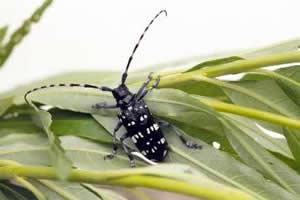 |
|||||||||
|
|||||||||||||||||||
Search
for Citrus Longhorn Beetles Defra are asking for the public's help to find any citrus longhorn beetles ( Anoplophora chinensis ) that may be in the UK.
The citrus longhorn beetle is a quarantine listed pest that could pose a threat to trees in the UK. A small number of adult beetles, believed to be citrus longhorns were found emerging from a potted Japanese acer/maple tree in a private garden in Shropshire early in July. One of these beetles was caught, photographed and then released before the beetles' identity was discovered. Last year similar sightings were made in Hampshire and Lancashire. The citrus longhorn beetle originates in Asia, but it has been moving around the world in internationally traded bonsais and young trees. There is currently an outbreak of this pest in northern Italy. Although predominately a pest of citrus and apples, the beetle can also attack a number of other trees including beech, hazel, oak, maple and birch. The larvae (grubs) of the beetle are the most damaging. They bore through the trunks, upper roots and branches of host trees leaving them susceptible to wind damage and disease. Later, perhaps 2 years after the first attack, the larvae will pupate and then emerge in the late summer as adult insects which will quickly seek out new host trees for the females to lay their eggs in slits they chew in the bark. The long period between egg laying and adult emergence explains how this pest can be moved from one country to another in young plants. The beetles are large, 21-37mm long (about 1-1.5 inches), excluding the antennae, and black with variable white markings on their backs. Their antennae (horns) are longer than their bodies and are black with white or light blue coloured bands. Late July to early September is thought to be the time of year when this pest is most likely to be seen.
|
|||||||||||||||||||

|
|
||||||||||||||||||
| home | agri-services | pedigree
pen | news | dairy | beef | machinery property | organisations | site map |
|||||||||||||||||||

